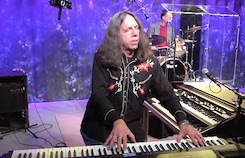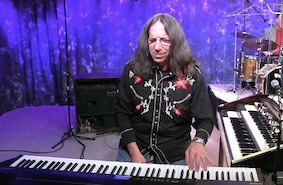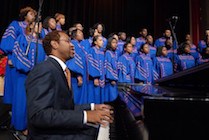How To Play Blues Piano – Turnarounds
 Want to learn how to play blues piano? Want to learn some classic blues piano chords and moves?
Want to learn how to play blues piano? Want to learn some classic blues piano chords and moves?
You’ve come to the right place!
In today’s blues piano lesson I’m going to teach you how to play a must know blues piano turnaround. (free video lesson below)
This is a super famous turnaround and you’ll hear hundreds of blues piano legends use these exact chords. You can even use it in rock and jazz too. Very useful to know!
Why This Free Blues Piano Lesson Is Special
We’ve created this free lesson to celebrate the release of our brand new blues piano DVD. It’s called …
“The Breakthrough Blues Piano Method”
Blues Hall Of Fame Pianist, Bruce Katz, and I created the “Breakthrough Blues Piano” program after spending literally THOUSANDS of hours on stage, in the rehearsal studio, and in lessons with students.
 Fortunately, you won’t have to spend thousands of hours and years of your life.
Fortunately, you won’t have to spend thousands of hours and years of your life.
We’ve made the learning process easy for you. So, we put tons of our blues discoveries in the DVD.
Yes, we share hundreds of our most closely guarded pro blues and jazz piano secrets.
95% of piano players don’t know these techniques. And those that do rarely share them. Bruce is a generous soul!
So, we’re very excited to be able to show you how to play all these amazing techniques.
Expensive Private Lessons Vs. Breakthrough Blues Method DVD
The best part is that the course will be affordable for all budgets. It’s 95% less than the cost of private lessons for a year.
We’ll be releasing several more sample lessons from the DVD and more free goodies in the coming weeks.
In the meantime, enjoy today’s free vid and get started learning these blues piano turnaround chords.
Update: The Breakthrough Blues Piano Method has been released. You can grab a copy by click right here
How To Play Blues Piano – Turnaround Video
Take 5 minutes and watch as I show you how to play these classic chords. They’re easy to play and sound awesome.
I’ve used these chords on hundreds of gigs. You can use them to:
- Start your songs
- End your songs
- Most importantly, you can use them to loop your blues songs as well.
Just make sure you insert them in bars 11 and 12 of a 12 bar blues chord progression.
5 Important Tips For Mastering This Blues Piano Lesson
1. How A Single Note Can Drive The Whole Chord Progression!
Notice that for the first bar of this turnaround, you’ll be playing a C note on top of each chord shape on each beat until the first beat of the second bar.
This is a pretty common feature in turnarounds.
The high tonic note is great because it accents the tension of the chords you’re playing underneath it.
It creates this beautiful feeling of familiarity and tension at the same time.
2. Watch The Classic Triplet Scoop
The F-F#-G triplet on the second beat of the second measure is the point of the turnaround that really is most important.
It get’s us to our V chord, which is the thing that pulls us – and your audience – back to the 1 chord.
This area of our turnaround is like a great recharger for both you and your audience!
3. This Scale Move Brings In A Gospel Flavor
 The right hand notes at the end, come from the C Major Pentatonic Scale (C-D-E-G-A).
The right hand notes at the end, come from the C Major Pentatonic Scale (C-D-E-G-A).
This provides the upward momentum that will draw the listener in and wait for another great chorus of blues when you use this turnaround to loop your forms.
Can you hear how when I play it brings in a little gospel flavor?
As you continue to learn how to play blues piano you’ll want to explore other gospel elements.
(Hello Ray Charles!)
4. How I Use The Tremolo To Add Flavor
Another cool technique you should listen for is the tremolo I do in octaves at the end of the turnaround. This is the first beat of Bar 1 in a 12-bar blues form.
Notice the difference between playing a tremolo like that versus just holding that C octave at the end.
Do you see how it changes the flavor and feeling of that chord?
Play it both ways so you can see how the tremolo adds to the overall bluesiness of the turnaround’s sound.
5. You Can Also Use This In Your Jazz Playing
Don’t be fooled by the overt blues sound of this turnaround. You can also adapt it to your jazz playing once you’ve mastered the technique.
Especially when you’re playing a jazz blues tune like Straight No Chaser.
You’ll hear master players like Oscar Peterson, Ray Charles, Gene Harris, and many others use this type of turnaround.
Learn From A Blues Piano Master
By the way, if you haven’t seen Bruce play yet check out his song “Norton’s boogie” in this blues piano tutorial. You can also watch him burn right here… (Yes, even more goodies for you to learn how to play blues piano.)
If you have any questions on today’s lesson or the new DVD please leave a comment below. I read every comment and I’m happy to help!
We’re committed to help you learn how to play blues piano.
See you next lesson and get some practice in!
Update: The Breakthrough Blues Piano Method has been released. You can grab a copy by click right here
